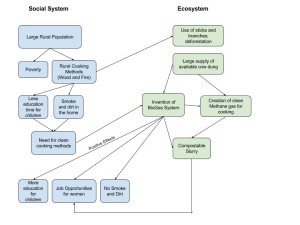
The core idea of my diagram is how a large rural population still using old, harmful fire and wood cooking methods led to the birth of the BioGas system shown in the video, and then the positive effects the system has on the social systems of rural India. The system creates a positive feedback loop, as it causes more performances because of its actions. It creates more time for children to gain an education, a clean cooking environment, and more job opportunities for the women that sell the fertilizer that is composted from the leftover slurry. This seems to be a very sustainable system as well, as it leaves more vegetation for the cows to eat (rather than it being used as a cooking fuel) and produce the waste needed to run the system. It is also a very stable system because there is very little to disturb the underground BioGas system. Compared to the diagram in Figure 1.5, they are the same in the way that the population creates a demand and need for the new technology. They are different because my diagram includes the results of the biogas generators, and Figure 1.5 relates the result of cooking fuel right back to the population. The diagram in Figure 1.5 organizes the nodes in ways that creates larger loops so the process can repeat itself. It is good to compare to see not only how an expert analyzes the system, but to see things that may have been missed. For example, the use of animal dung and plant residues not only helps fuel the biogas generators, but it is used for fertilizer too. Therefore, the more that is used in the generators, the less there is to create fertilizer to create healthy farms, although the resulting slurry from the biogas generator helps to create fertilizer as well.

Hello Kyle! My name is Tom and I responded to your diagram because of the interesting differences between yours and mine. I really liked how your social system flows downward with the population at the top. I agree that this system has the potential to be a positive feedback loop. We also differed in that my bubbles only had objects with the arrows labeled with how they affect the other objects or systems. Here is the link to my blog: http://geog030.dutton.psu.edu/2016/01/27/thomas-devenney-learning-activity-module-2/